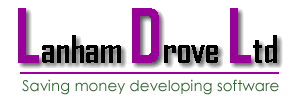|
 R&D
Tax Relief for Software Development R&D
Tax Relief for Software Development
Many organisations assume that the work they
do cannot be considered to be “Research and Development”,
and therefore the tax relief/credit cannot be available to
them. Others assume that the effort required to construct
a claim will make the exercise worthless. These issues are addressed below.
“The tax relief benefit is surely marginal – what
sort of Return On Investment can I expect ?”
On
a recent assignment for a large software company, for each £1,000
spent investigating and assessing development activities, £200,000
of eligible costs were identified. The value of the equivalent
tax relief was £50,000, resulting in a bottom-line
cash benefit of £15,000 – for each £1,000
spent ! For SMEs, the return is of course double that.
"Isn't the benefit only available
to small companies ?"
No.
When the scheme was first introduced it was
only available to SMEs, but it is now available to all companies."
“What is the definition
of an SME (Small or Medium Sized Enterprise) ?”
The
Revenue’s
definition of an SME is the same as the European Commission’s,
i.e. an SME is a company with fewer than 250 employees
and either turnover not exceeding €50M or a
balance sheet totalling less than €43M, and which
is not part of a larger business which would fail these
tests. A company exceeding one or more of these limits
is considered to be a Large Company.
“Our
work is mostly funded by our customers; surely we can only claim
that work is R&D if we are
funding it ourselves ?”
Not at all. It’s
the nature of the work which counts, not the payment arrangements.
If the work is eligible and you pay corporation tax then
you can claim the relief or credit. You can of course take
advantage of this to make your pricing correspondingly
more competitive. An exception to this is if the customer
is an SME, in which case they will be able to claim the
relief.
“Can we claim for the costs of
eligible work which we subcontract to other organisations
?”
It depends on the nature of the supplier organisation. If they can themselves
claim the relief or credit, then the customer cannot do so. But if you subcontract
eligible work to universities or recognised research organisations (or other
bodies which do not themselves pay corporation tax) then yes you can claim the
relief or credit.
“Is it a tax relief
or a tax credit ?”
The
scheme was initially only for Small and Medium size Enterprises,
and could be paid as a tax credit if there was insufficient
tax payable to cover its value. The later extension to cover
large companies does not provide for a credit to be paid,
so it is more accurately described as a relief.
“What
are the main differences between the SME and Large Company schemes
?”
The headline
difference is that SMEs can claim a super-deduction of
50%, whereas large companies can only claim 25%. SMEs must
own the IPR on developed products (but see below). SMEs
can also have the value of the relief paid.
“Do
we have to own the Intellectual Property Rights to any software
developed ?”
If you
are an SME, then in order to be able to claim the 50% super-deduction,
you do need to own the IPR. For large companies there is
no such requirement, and our understanding is that SMEs
which will not own the IPR can still claim the relief at
the large company rate (25%).
“What costs can be
included ?”
The
only costs which can be included in a claim are those which
directly relate to eligible work. In the case of software
development, these are usually predominantly the costs of
effort, but they can also include bought-in software packages
and “consumables” such as power, heat, light
and water.
“What sort of work
is eligible ?”
Two
main criteria for eligibility are innovation and uncertainty.
This can for example include developing novel products, or
integrating components in novel ways. It is not enough for
products to be novel only as far as the developing company
is concerned. This is an area where external knowledgeable
expertise is invaluable.
“Do we have to have
detailed records of all costs ?”
The more
detail there is, the easier it is to construct a claim.
Where work is charged directly to a customer then there
will normally be project costings available. We have,
however, constructed successful claims (e.g. for product
development) where there was no directly funding customer
and where only payroll costs were available.
|

 R&D
Tax Relief for Software Development
R&D
Tax Relief for Software Development